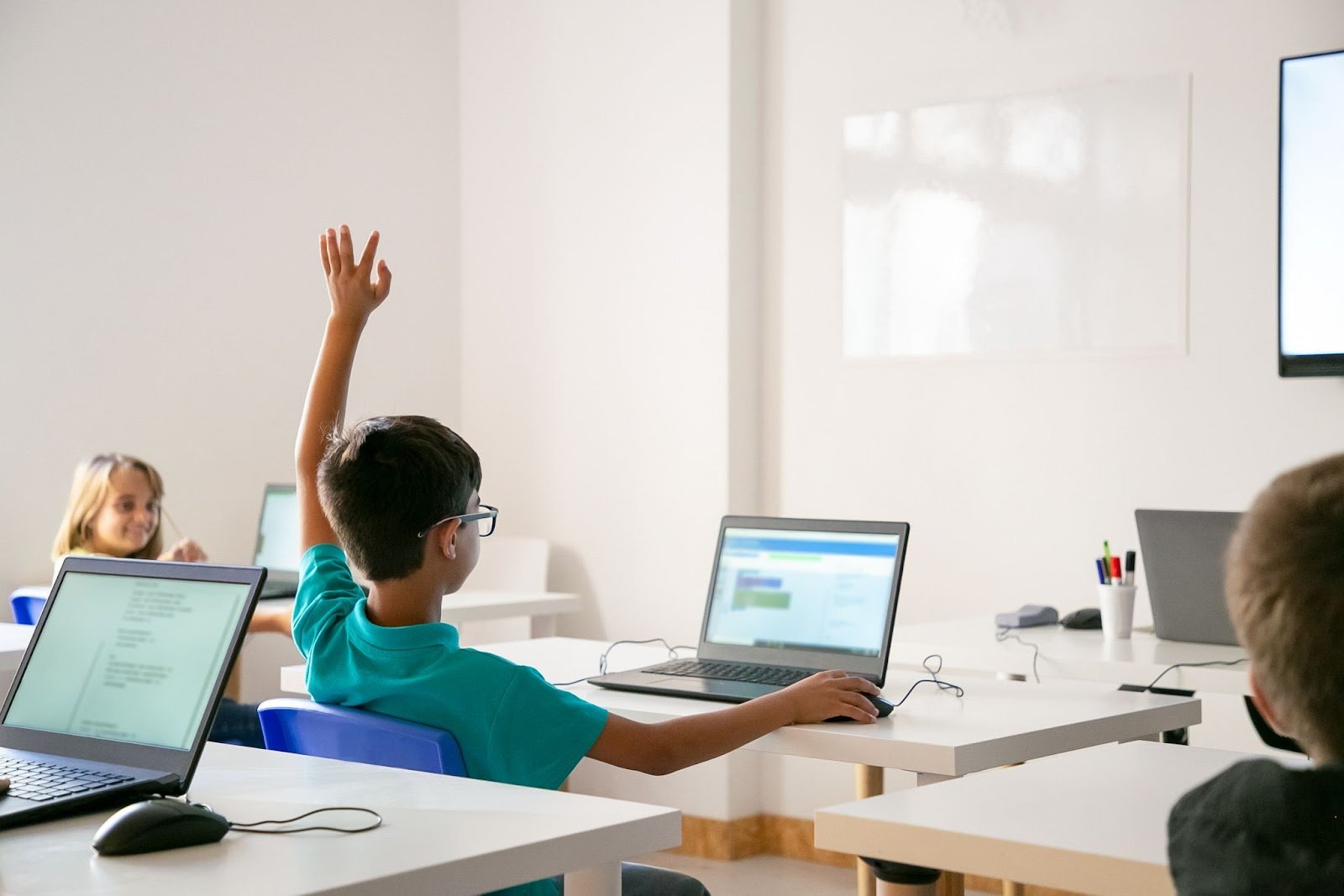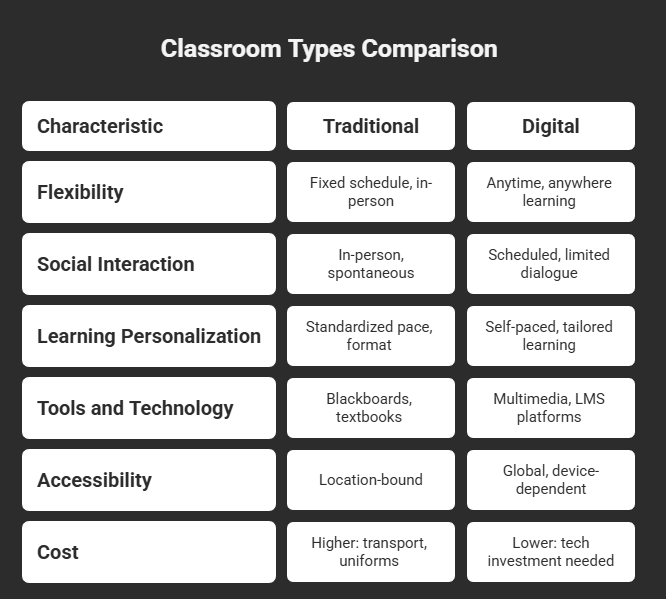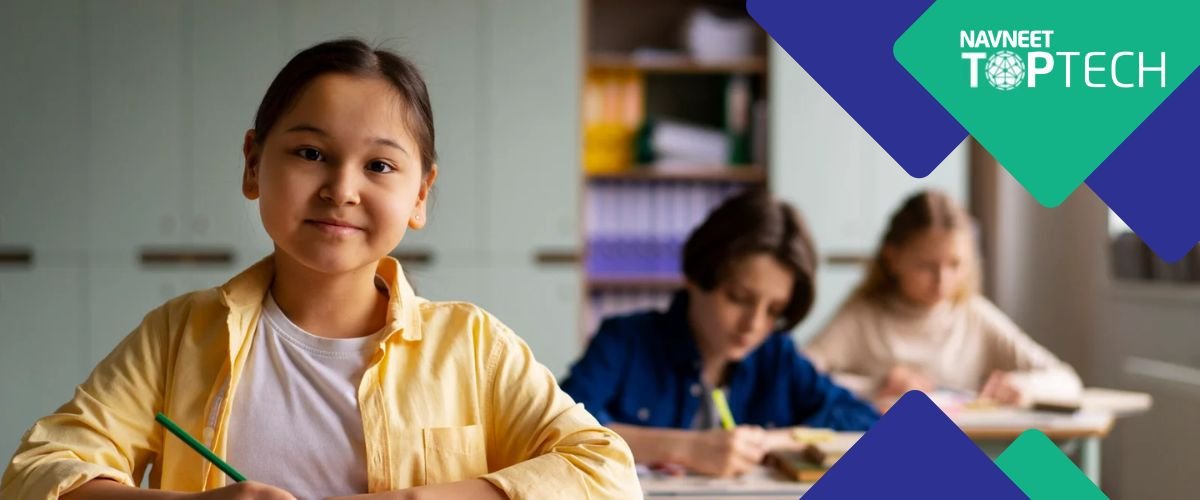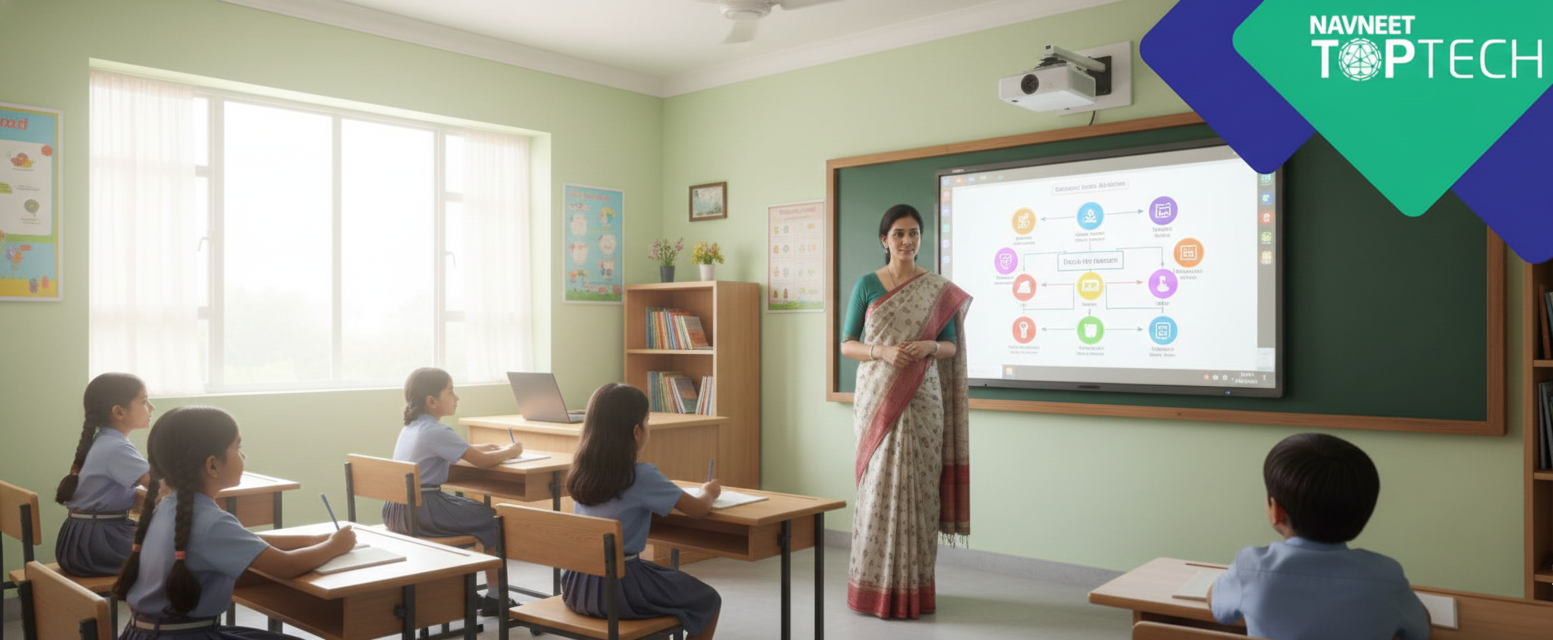Over the past few years, education has seen a radical transformation. The pandemic fast-tracked a shift to tech-driven learning, and by 2025, the debate between digital education vs traditional education is more relevant than ever.
But which one actually works best? Is digital education replacing traditional classrooms—or can both co-exist?
This blog explores the pros and cons of each model, and why the future of learning might not be about choosing one over the other, but blending both.
What Is a Traditional Classroom?
A traditional classroom is the classic setup we’ve known for decades—students physically present in a room, learning from a teacher in real time. Despite all the innovation, traditional learning still plays a major role, especially for younger learners.
Pros of Traditional Classrooms
- Builds Discipline and Structure
Routine is the backbone of traditional education. Fixed schedules and physical attendance help students develop time-management skills and a sense of accountability. - Responsive Teaching
A physical classroom allows teachers to read non-verbal cues, adjust their teaching accordingly. The face-to-face immediacy enhances comprehension and keeps students engaged in the moment. - Promotes Social Skills
Class discussions, group projects, and even informal hallway conversations contribute to holistic personal development, building communication skills, emotional intelligence, and a sense of belonging. - Focused Learning Environment
Being in a classroom removes many of the distractions found at home. It’s a space designed for learning, which helps students focus and learn.
But traditional classrooms aren’t perfect, and in some areas, they struggle to keep up with modern educational needs.
Challenges of Traditional Classrooms
- Lacks Flexibility
The requirement to be physically present every day can pose challenges for students with health issues or unique circumstances. - One-Size-Fits-All Pace
In large classrooms, teachers often teach to the average, which means fast learners get bored, and slower learners may fall behind. There’s little room for custom learning paths. - Geographically and Economically Limited
Students in rural or under-resourced areas have limited access to quality schools. Even when available, traditional schooling can come with costs for transport, uniforms, and materials that make it less accessible. - Less Integration with Technology
While many classrooms have added smart boards or digital resources, the traditional model is still largely analog, limiting exposure to tools that students will need in higher education or the workforce.
What Is a Digital Classroom?

The digital classroom, by contrast, is a virtual space where learning takes place through technology. It’s a model built for flexibility, scale, and personalization.
Key Digital Classroom Advantages for Students in 2025
- Personalized Learning
Online platforms often let students move at their own speed. They can pause videos, revisit difficult material, or jump ahead when they’re confident, empowering them to take charge of their learning journey. - Access to Global Resources
Online education breaks geographical barriers, connecting students to top educators, content libraries, and peer communities across the world, creating richer, more varied learning experiences. - Self-Reliance and Digital Literacy
Students learn to manage their own schedules and become proficient with digital tools, skills essential in today’s workforce. - Cost-Effective
Without transportation, uniforms, and printed materials, digital classrooms can be a more affordable option for many families.
These digital classroom advantages make online learning especially effective for older students, working professionals, or learners in remote locations.
Challenges of Digital Classrooms
- Digital Divide
Access to education is dependent on reliable internet access and a functioning device, a significant barrier for many students in underserved communities or those from underdeveloped regions. - Limited Physical Social Interaction
Lack of face-to-face contact can impact emotional development, teamwork, and peer learning, especially in younger students. - Risk of Screen Fatigue and Distractions
Too much screen time can reduce attention and strain mental focus, especially without structured breaks and routines. - Higher Demand for Self-Discipline
Students need strong time-management skills, which not all learners naturally possess. Without dedicated concentration and internal drive, distractions at home can quickly derail focus
Traditional Learning vs Digital Learning: Comparison Table
When comparing smart learning vs traditional learning, it’s clear that both have their place depending on the student’s needs, access to technology, and learning style.

Which Classroom Style Suits Which Type of Learner?
Education isn’t one-size-fits-all. Some students thrive on structure, others on independence. Understanding the match between learning style and environment is crucial.
Traditional Classrooms Are Better For:
- Young learners need routine and discipline
- Students who thrive on face-to-face interaction
- Areas with limited tech infrastructure
Digital Classrooms Work Best For:
- Self-driven students who learn better independently
- Learners in remote or underserved regions
- Those seeking flexibility (like working students)
- Visual and tech-savvy learners who enjoy interactive content
Has digital education taken over traditional education?
Not really. Digital education is growing fast. It brings flexibility, interactive tools, and access to quality content anytime, anywhere. But that doesn’t mean it’s replaced the classroom.
Traditional education still matters, especially for younger students. It offers structure, discipline, in-person interaction, and hands-on learning that screens can’t fully match.
The future of education is not one versus the other. It’s about combining both to make learning better. Digital tools should support and strengthen classroom teaching, not replace it.
Can Digital Education Replace Traditional Education?
This is one of the most frequently asked questions in modern education, and the answer is more nuanced than a simple yes or no.
Online classes offer tremendous advantages in terms of scale, accessibility, and personalization. But they can’t fully replace the emotional, social, and human components of offline learning. In-person schools provide structure, mentorship, and peer interaction in a way digital platforms still struggle to match, especially for younger students.
Instead of viewing online learning as a substitute, it’s more productive to see it as a complement to offline methods, a vital part of a future-ready system.
Why Blended Learning Is Replacing the Traditional Classroom in Many Schools
As more schools adopt smart learning systems, the rigid structure of the traditional classroom is being enhanced and not replaced by technology-driven methods.
The most realistic and effective future of education lies in hybrid learning. It’s a model that combines the strengths of both digital and traditional classrooms.
Hybrid education doesn’t just bridge gaps; it reshapes how education adapts to each student. At NAVNEET TOPTECH, we are proud to be at the forefront of this transformation, bringing digital classroom solutions to schools across India. We’re facilitating them in embracing digital learning with NEP-aligned content, interactive platforms, and teacher enablement programs. Our mission is to make education more effective, inclusive, and future-ready. Our mission is to make blended, future-ready classrooms accessible and effective for every learner.
What Works Best in 2025?
In 2025, the conversation is no longer about choosing between online and offline learning; it’s about creating an integrated experience that brings the best of both worlds together. The debate of Digital vs Traditional Classroom now focuses on building adaptable systems that support every type of learner.
At NAVNEET TOPTECH, we don’t see digital and traditional as opposites, but complementary. Our solutions are built around this belief. Through products like TopSeries, we deliver a holistic learning experience that combines the familiarity of physical books with the power of a Learning Management System (LMS). This integrated model supports students through a blended journey, reinforcing classroom instruction while enabling digital flexibility.
The best classrooms of today aren’t defined by physical walls or digital screens—they’re defined by adaptability, empathy, and the ability to meet every learner where they are. The real question isn’t whether the Digital vs Traditional Classroom is better, it’s how we design systems that take the best from both.
The future isn’t binary. It’s blended, inclusive, and learner-centered.
Frequently Asked Questions
1.What is the difference between digital classrooms and traditional classrooms?
Digital classrooms use technology to deliver interactive lessons, personalized learning, and real-time assessments, while traditional classrooms rely on in-person teaching, structured schedules, and physical materials.
2.Can digital education replace traditional schooling completely?
No. Digital education complements traditional learning but cannot fully replace face-to-face interaction, mentorship, and social development, especially for younger students.
3. How do digital classrooms align with the CBSE curriculum?
Digital classrooms can integrate CBSE-aligned content, interactive quizzes, virtual labs, and real-time assessments to support curriculum objectives and student learning outcomes.
4. Are digital classrooms cost-effective for schools and parents?
Digital classrooms can reduce costs related to printed materials, transportation, and uniforms. Initial setup for devices and software is an investment, but long-term savings and learning benefits are significant.




